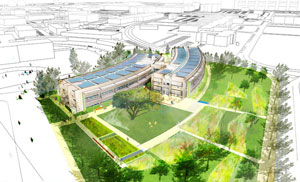Solar Revival
Design & Photovoltaics
In his lectures, architectand author Ed Mazria, FAIA, who founded the 2030 Challenge, often begins with the point that more than enough solar energy falls on the average building to power it over the course of a year. Emerging technology and lower costs are bringing this vision closer to reality. One challenge for designers has been in detailing solar components in a way that is integral to the design of the building. The image of an alien-looking solar array bolted to the roof of a structure is giving way to new design approaches that incorporate PV as an aesthetic element rather than an appliance.
Recently, several architects have featured PV in high-profile projects. Japanese architect Toyo Ito ringed the stadium for the 2009 World Games in Taiwan with an enormous snaking arc of PV panels. The 8,840 panels shade the seating areas and are expected to provide 1.6 million kilowatt hours of electricity annually. The project has apparently started a trend in emblematic solar stadium design with similar proposals for Tokyo's 2016 Olympic and Dubai's 2022 World Cup bids.
The firm of William McDonough + Partners used a solid PV array on the vaulted roof of the net-zero Lewis Center at Oberlin College completed in 2000. The project demonstrated that architects, balancing efficiency and design, could orient PV panels at less than optimal angles and still produce a substantial amount of power. More recently, McDonough incorporated rooftop panels and thin-film shades over the south-facing windows in the NASA Sustainability Base in Ames, California.
 |
Photovoltaic panels will generate about 30 percent of the power needed at the NASA Sustainability Base in Moffett Field, California. Image: William McDonough + Partners |
The endeavor was spearheaded by Steven Zornetzer, NASA at Ames associate director, who saw the project as an opportunity for the building to be a net-energy producer and a test bed for emerging technology.
"NASA is in some ways the reason that PVs are where they are today-[much of the development of photovoltaics is] due to the research for powering the early space vehicles of the 60s and 70s and Skylab," says McDonough + Partners project manager Alastair Reilly, AIA. So it made sense for PV to play an important role in the building.
As with other high-performance projects, the goal was to make the building as efficient as possible to reduce the amount of PVs required. According to Reilly, building loads were reduced by about 50 percent using an efficient envelope, maximizing natural ventilation, and optimizing building shape and orientation. The level roof of the building accommodates a large array of flat PV panels, and south-facing windows are shaded with horizontal building integrated PVs (BIPV), which are photovoltaic cells laminated between two sheets of glass.
Net-Metering: Systems for Day and Night Energy |
 |
Of course PV has its dark side. When the sun goes down so does the flow of electrons. Off-the-grid systems address this issue by using storage batteries, which require space and add cost. A good option when a project has access to the grid is net-metering. Utilities that allow net-metering pay for excess power that is generated by PV during the day so that the building's electrical meter runs backwards. When the building uses more juice than it's generating, the meter runs forward. For example, a 25-panel array on a single-family home might have the capacity to produce 6 kilowatts. Under good conditions that array may generate 30 kilowatt hours (kWh) of electricity per day. If the family needs 20 kWh of energy daily, they're generating 10 extra kilowatts for rainy days. Two free online software programs can be set up to keep track of a PV array's performance. Both Google PowerMeter and Microsoft Hohm provide continuous building energy analysis-including PV system performance-on a home or office computer. Illustrations by La Boca |









